CONTENTS
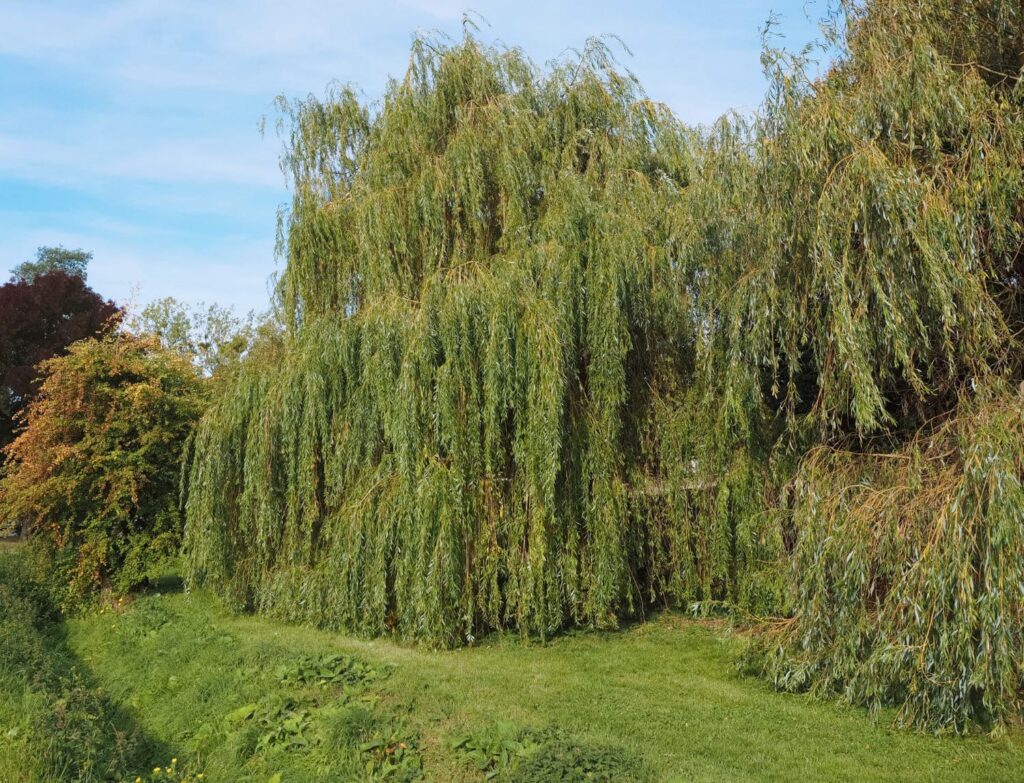
Discover the Power of Fast Growing Trees: Transform Your Landscape in No Time
Have you ever looked out at your backyard and wished it could be transformed into a lush oasis of greenery? A place to relax and unwind, surrounded by the beauty of nature. The thought may have crossed your mind, but the reality of waiting years for trees to grow to their full potential can be discouraging.
However, what if we told you that there are fast growing trees that can transform your landscape in no time? Ahead, we’ll explore the best fast-growing trees and how they can help you achieve your dream garden in just a few short seasons. Say hello to a thriving and vibrant outdoor space in no time!
Best Fast-growing Trees
Are you ready to transform your landscape with the power of fast-growing trees? Get started with these recommendations!
Japanese Flowering Cherry
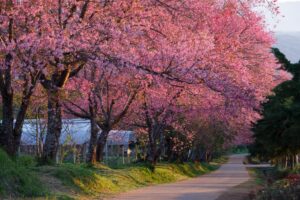
The Japanese Flowering Cherry, also known as Sakura, is famous for its breathtakingly beautiful pink blossoms that bloom in early spring, creating a jaw-dropping display of color that will leave you in awe.
The Sakura grows rapidly, reaching up to 15-25 feet tall in just a few years, making it an ideal choice for those who want to quickly add height to their landscape.
In addition, this tree also provides a calming and tranquil atmosphere with its delicate fragrance and soothing shade—perfect for afternoon tea time in the backyard!
Bald Cypress
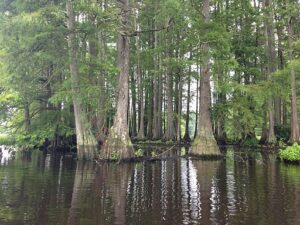
The Bald Cypress is an adaptable and resilient tree. This coniferous tree is native to the wetlands of the southeastern United States and has a unique feature of developing “knees” or woody projections from its roots, which adds to its charm and character.
The tree commonly grows at a moderate pace of 1-2 feet per year, but in optimal conditions, it can grow up to 3 feet per year, reaching heights of up to 50-70 feet at maturity.
One of the most remarkable qualities of this tree is its ability to thrive in both dry and wet conditions, making it a perfect choice for those looking for a tree that can withstand various weather conditions.
On top of that, it also provides ecological benefits, like reducing soil erosion, improving water quality, and providing habitat for wildlife.
Red Maple
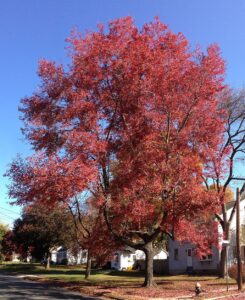
Add some colors to your backyard with the Red Maple tree, also known as Acer rubrum. As its name suggests, this tree is known for its striking red foliage, brilliant orange, and golden yellow, which makes it a gorgeous addition to any landscape that needs a pop of color.
This deciduous tree grows rapidly, reaching heights of up to 40-60 feet in just a few years, making it an ideal choice for those looking to quickly add height to their garden.
One unique quality of the Red Maple is its adaptability to various soil types and climates, making it a versatile choice for various locations. Its hardiness also makes it an excellent choice for those who live in areas with harsh winters. You may need a leaf blower to blow the fallen leaves during the fall seasons, though.
Weeping Willow
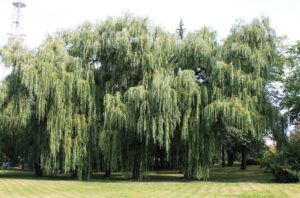
Need some privacy? Consider planting a Weeping Willow tree. It can grow up to 6-8 feet a year, making it an excellent choice for creating natural shade and privacy screens.
This tree is often planted near water sources, such as rivers and lakes, due to its love for water and fast growth rate. Its rapid growth makes it an ideal option for homeowners or landscapers looking for quick results.
People choose this tree to plant because of its unique appearance, with long branches that droop elegantly toward the ground, giving it a graceful and serene look.
Chinese Tallow Tree
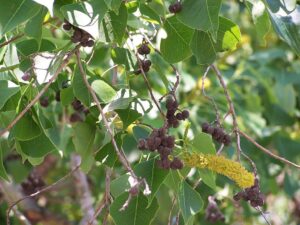
Another excellent choice for homeowners looking for quick results is the Chinese Tallow tree. It typically grows up to 20 feet tall, but in some cases, specimens can reach up to 50 feet.
This tree is known for its beautiful display of fall foliage, which turns into shades of yellow, red, and purple.
However, it’s important to note that the Chinese Tallow Tree has some significant pros and major cons. While it’s resistant to pests and tolerant of many environmental conditions, it’s also considered an invasive species and can easily spread by birds that consume its seeds.
Therefore, it’s important to plant the tree responsibly and take measures to prevent it from becoming a problem in natural areas.
River Birch
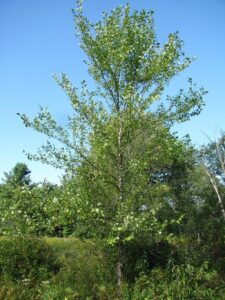
Known for its rapid growth rate, the River Birch tree is another alternative for a fast-growing tree. Typically growing up to 2 feet per year, it can reach 40 to 70 feet tall at maturity.
Aside from its quick growth rate, this tree is so pretty, with unique bark that peels off in curly, papery sheets, revealing shades of cream, peach, and salmon-pink underneath.
Additionally, the River Birch can tolerate various soils and environmental conditions, making it easy to maintain and care for.
However, it’s important to note that River Birch trees have relatively short lifespans, typically living for around 30 years.
Koa
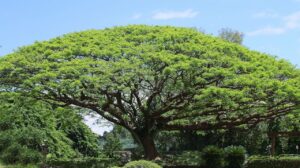
Scientifically known as Acacia Koa, Koa is known for its rapid growth rate, reaching up to 5 feet per year for the first five years. This tree typically grows up to 30-40 feet tall with 2-3 feet of trunk diameter.
Koa is prized for its beautiful wood, which is known for its hardness, durability, and unique grain patterns.
However, it’s important to note that while Koa is fast-growing, it has a relatively short lifespan, typically living for a few decades. Moreover, Koa is native to Hawaii and may not be suitable for growing in all regions due to its specific environmental requirements.
Cottonwoods and Lombardy Poplars
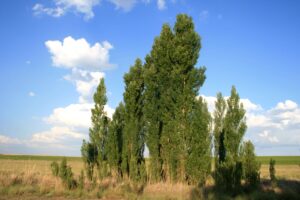
Cottonwoods and Lombardy Poplars are two relatives that are great for your garden.
Cottonwoods, or Populus deltoides, can grow up to 100 feet tall and 6-8 feet in diameter. They grow rapidly, with a growth rate of up to 6 feet per year in their early years. While they are often used in commercial landscapes, they may not be suitable for smaller residential properties due to their large size.
Meanwhile, Lombardy Poplars, also known as Populus nigra ‘Italica’, are tall, columnar trees that can reach up to 70 feet tall with a growth rate of up to 3-4 feet per year. They are often planted in rows to create a dense screen or windbreak.
However, they have a relatively short lifespan of around 30 to 50 years and are unsuitable for all regions due to their specific environmental requirements.
Cider Gum
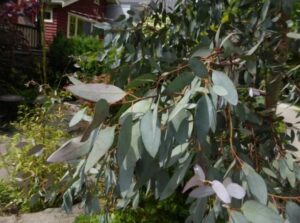
Native to Australia and known for its silvery-blue foliage and attractive bark, the Cider Gum typically grows up to 40-60 feet tall with a spread of 10-20 feet. It has a rapid growth rate, reaching up to 5 feet per year in its early years.
Cider Gum is not only an attractive ornamental tree but can also be used for creating privacy screens or windbreaks. It is drought-tolerant and relatively easy to grow, making it a low-maintenance tree for homeowners.
However, it’s important to note that this tree is not suited for all regions and may not be adaptable to colder climates. Additionally, it may require regular pruning to maintain its shape and avoid damage from high winds.
Pin Oak
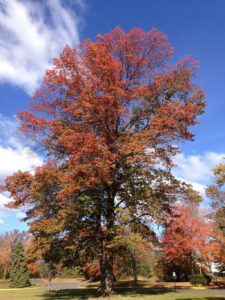
Known for its striking red fall color and attractive pyramidal shape, the Pin Oak is one of the fast-growing deciduous trees native to North America. It typically grows up to 60-70 feet tall with a spread of 25-40 feet, with up to 2-3 feet growth rate per year.
As a young tree, the pin oak has a pyramidal shape which later becomes more rounded and slender than other oaks. Its shiny dark green leaves and gray-brown bark with mature ridges remain distinctive features as it ages.
What makes it unique is that it provides shade and shelter for wildlife. On top of that, this fast-growing shade tree is tolerant of wet soil as long as the soil is acidic.
Frequently Asked Questions
What is the quickest-growing tree?
The Paulownia tree, scientifically known as Paulownia fortunei, is the fastest-growing tree compared to other trees. The young trees showcase 15 feet of addition each year, with 50 feet of mature height in just ten years.
What is the fastest-growing privacy tree?
The Leyland Cypress is the fastest-growing privacy tree, with 4 feet growth rate per year. It rapidly forms a dense, lush barrier to shield your property and create a partial shade for your outdoor space.
Which tree gives more oxygen?
The Oak tree is known for producing significant oxygen, making it a top contributor to our planet’s oxygen supply.
Conclusion
In conclusion, planting fast-growing trees can be an excellent way to transform your landscape quickly. Not only do these trees add aesthetic appeal to your property, but they also provide various environmental benefits, such as shade and shelter for wildlife.
However, it’s important to remember that fast growth doesn’t necessarily mean less maintenance. It’s crucial to research the specific needs of each tree species and ensure they are appropriate for your local climate and soil conditions.
By selecting the right fast-growing trees and giving them the proper care, you can create a beautiful and sustainable landscape that will last years. So start planting today and watch your landscape transform before your very eyes!

